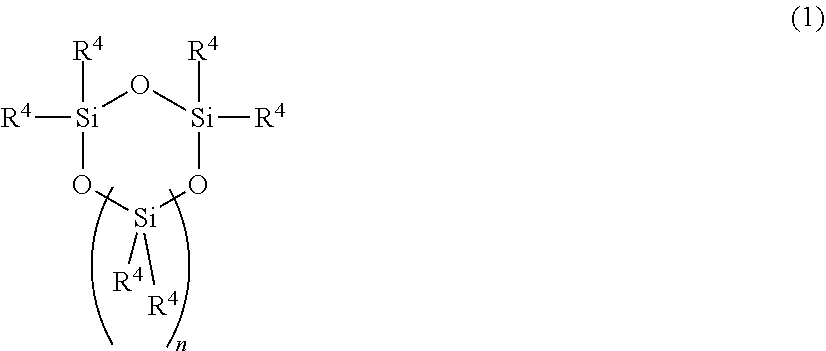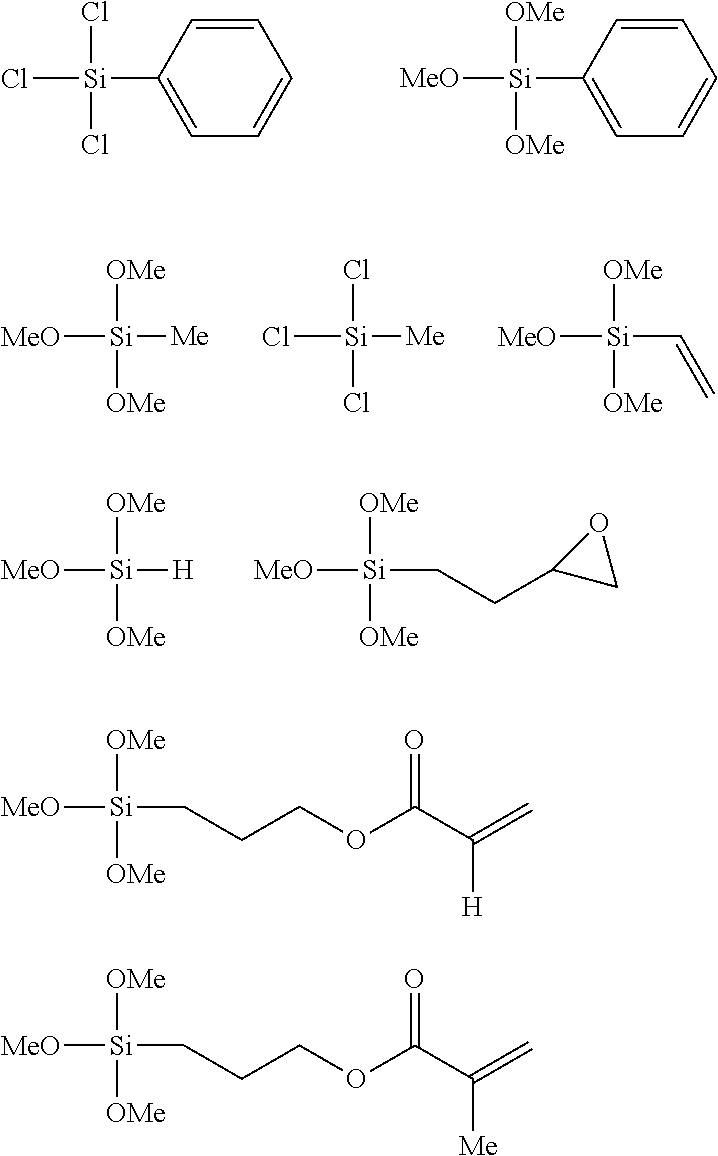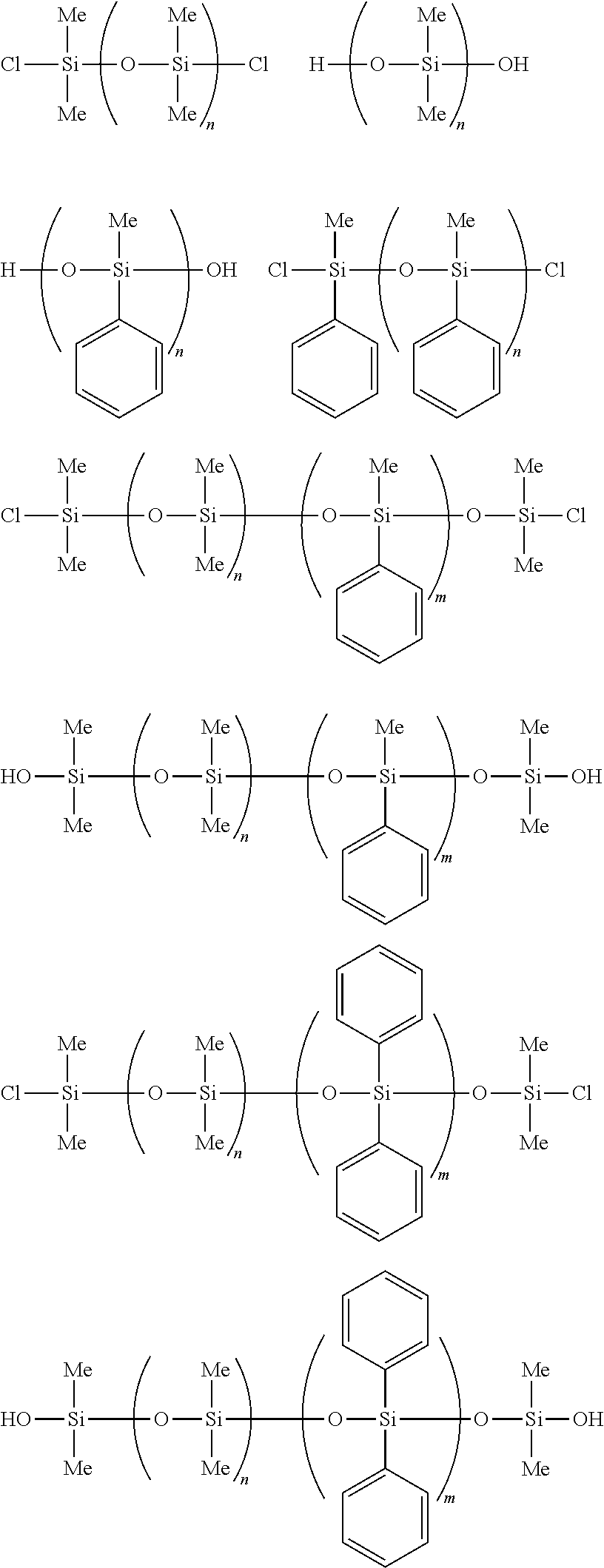Curable organosilicon resin composition and semiconductor device
a technology of organosilicon resin and composition, which is applied in the direction of semiconductor devices, electrical equipment, basic electric elements, etc., can solve the problems of prior art thermoplastic resin lens no longer being used, lens peeling from the substrate, heat resistance and discoloration resistance of thermoplastic resin, etc., to achieve effective moldability and curability, improve heat resistance and mechanical properties, and improve transparency
- Summary
- Abstract
- Description
- Claims
- Application Information
AI Technical Summary
Benefits of technology
Problems solved by technology
Method used
Image
Examples
example 1
[0076]A silicone rubber composition was prepared by combining and thoroughly stirring the following components:
[0077](A) 30 parts of a branched phenylmethylpolysiloxane consisting of 55 mol % of PhSiO3 / 2 units, 40 mol % of Me2SiO2 / 2 units and 5 mol % of ViMe2SiO1 / 2, units (Mw=50,000, silicon-bonded hydroxyl content: 0.8 mol / 100 g, silicon-bonded alkoxy content: 0.5 mol / 100 g, average number of continuous Me2SiO2 / 2 units: 20),
[0078](B) an organohydrogenpolysiloxane having the formula (3):
wherein p=1, in such an amount that the ratio of the total number of silicon-bonded hydrogen atoms in component (B) to the total number of silicon-bonded vinyl groups in components (A) and (D) (i.e., SiH / SiVi ratio) was 1.0,
[0079](C) 0.01 part of octyl alcohol-modified chloroplatinic acid solution (platinum content: 1 wt %), and
[0080](D) 5 parts of an organosilicon compound having the formula (4).
The composition was heat molded at 150° C. for 4 hours into a cured product (120 mm×110 mm×1 mm), which w...
example 2
[0081]A silicone rubber composition was prepared by combining and thoroughly stirring the following components:
[0082](A) 30 parts of a branched phenylmethylpolysiloxane consisting of 50 mol % of PhSiO3 / 2 units, 40 mol % of Me2SiO2 / 2 units and 10 mol % of ViMe2SiO1 / 2 units (Mw=10,000, silicon-bonded hydroxyl content: 0.8 mol / 100 g, average number of continuous Me2SiO2 / 2 units: 20),
[0083](B) an organohydrogenpolysiloxane having the formula (3):
wherein p=1, in such an amount that the ratio of the number of silicon-bonded hydrogen atoms in component (B) to the number of silicon-bonded vinyl groups in component (A) (i.e., SiH / SiVi ratio) was 1.0, and
[0084](C) 0.01 part of an octyl alcohol-modified chloroplatinic acid solution (platinum content: 1 wt %). The composition was heat molded at 150° C. for 4 hours to form a cured product (120 mm×110 mm×1 mm), which was measured for physical properties. The results are shown in Table 1.
example 3
[0085]A cured product was formed as in Example 1 except that 30 parts of a branched phenylmethylpolysiloxane consisting of 50 mol % of PhSiO3 / 2 units, 35 mol % of Me2SiO2 / 2 units, 5 mol % of ViMeSiO2 / 2 units and 10 mol % of ViMe2SiO1 / 2 units (Mw=100,000, silicon-bonded hydroxyl content: 0.02 mol / 100 g, silicon-bonded alkoxy content: 0.04 mol / 100 g, average number of continuous Me2SiO2 / 2 units: 80) was used instead of component (A) in Example 1, and was measured for physical properties. The results are shown in Table 1.
PUM
| Property | Measurement | Unit |
|---|---|---|
| refractive index | aaaaa | aaaaa |
| temperature | aaaaa | aaaaa |
| temperature | aaaaa | aaaaa |
Abstract
Description
Claims
Application Information
 Login to View More
Login to View More - R&D
- Intellectual Property
- Life Sciences
- Materials
- Tech Scout
- Unparalleled Data Quality
- Higher Quality Content
- 60% Fewer Hallucinations
Browse by: Latest US Patents, China's latest patents, Technical Efficacy Thesaurus, Application Domain, Technology Topic, Popular Technical Reports.
© 2025 PatSnap. All rights reserved.Legal|Privacy policy|Modern Slavery Act Transparency Statement|Sitemap|About US| Contact US: help@patsnap.com



